Firefighters have used the term playpipe for nearly two centuries, but the reasons why are difficult to determine
Prior to the 1870s, building code as we know it didn’t exist in the United States—and the quality of fire protection equipment varied widely from city to city. But while rigorous manufacturing standards and deeply researched fire codes have completely changed the landscape of firefighting and public safety, their language is still riddled with terms from the past. One such term is “playpipe,” a tool used by firefighters and inspectors to control water flows.
In this article, we take a close look at firefighting playpipes, explaining why they’re valuable, how the term may have come to be, and how manufacturing standards set modern-day definitions of what a playpipe is.
If you’d like to shop for a firefighting playpipe right away, check out our UL-listed & FM-approved underwriter’s playpipe.
Firefighting playpipes enhance the quality of water streams, making tests of hydrants, pumps, and other fire protection equipment possible
Firefighting playpipes as we now know them emerged from a series of 19th-century studies showing that long pipes with smooth interiors create straight and effective streams of water. We’ve looked at the design and use of one such tool (the Underwriter’s playpipe) before. In short, playpipes evolved from something like a general-use firefighting hose nozzle to a specialty tool for inspectors. Today, firefighting playpipes help fire professionals measure how quickly water flows—particularly during tests of fire hydrants or fire pumps, as the video below demonstrates:
Every fluid-flowing orifice has what’s called a discharge coefficient. Variations in the shape, size, and construction of each nozzle or orifice cause friction and turbulence, which obstruct the passage of water. Discharge coefficients measure how much flow and pressure are lost as a liquid passes through a specific opening.
A perfect orifice would have a discharge coefficient of 1.00, allowing 100% of the flow and pressure to pass through. Some of the best fire hose nozzles get close—with coefficients exceeding 0.99—but never all the way to perfect discharge. Hydrant outlets, on the other hand, typically range from 0.7 to 0.9, resulting in significant reductions in flow and pressure.
The smooth interior of a firefighting playpipe reduces friction and turbulence, with many increasing that coefficient to 0.97. When inspectors know the coefficient of discharge, and the coefficient is high enough, they can accurately estimate the actual flow. During flow tests, they do so by placing a pitot tube—a handheld tool with a built-in gauge—in the center of the water stream. The pressure read on the pitot tube then converts mathematically to flow, typically in gallons per minute (GPM).
Curious about pitot gauges? Click here for an introduction to their use in hydrant flow testing.
Firefighting playpipes (aka “play-pipes” or “play pipes”) as we know them emerged in the late 19th century
It’s not easy to figure out how fire professionals ended up settling on the term “playpipe,” but archival sources show that the word has nearly two centuries of use in fire protection. One of its earliest known uses can be found in an 1830’s edition of Leigh Hunt’s London Journal, a short-lived publication that, among other things, discussed the use of steam in firefighting. In the Journal, playpipes direct the flow of steam—almost like a nozzle.
An 1890 issue of The Engineering & Building Record offers one of the first uses of the term “play-pipe” as a measuring or testing aid in fire protection. The Record provides a lengthy summary of experiments conducted by John R. Freeman—the inventor of the playpipe as we now know it—on the traits of “good” hose streams. Like today’s firefighting playpipes, Freeman’s version was a device connected directly to a hose or other water-flowing orifice. It featured an outlet for measuring pressure using a specialized tube and a pressure gauge and another outlet for a hose nozzle.
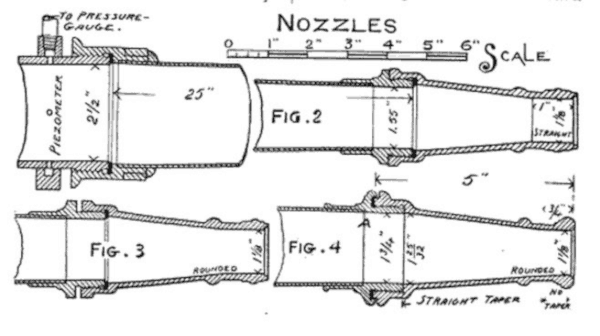
Freeman’s firefighting playpipe made it possible to measure the pressure of flowing liquid at a point very close to the outlet, giving a baseline measurement against which flows out of the nozzle could be compared. These early “play-pipes” had an impressive coefficient of discharge: 0.977, or nearly 98%. In the course of explaining these measurements, Freeman suggests that while a playpipe and a nozzle can be treated as a single part for testing purposes, the playpipe was then basically a tapered length of pipe joined to the nozzle itself.
While the origins of the term remain uncertain, the definitions and specifications for playpipes have become much clearer
These uses of the word leave our main question unanswered: why is it a playpipe? While the use of the space or the hyphen appears to have declined in favor of a single compound word, less-common meanings for the word “play”—those stressing action or motion—suggest that mobility or control over streams are the essential characteristics of playpipes.
Early 20th-century playpipes featured handles and a long grip that allowed users to control the stream’s direction. And today, the Defense Logistics Agency, which delivers supplies for the United States military, offers one of the few formal definitions of a playpipe: “a rigid extension to a standard fire hose that provides a gripping surface.”
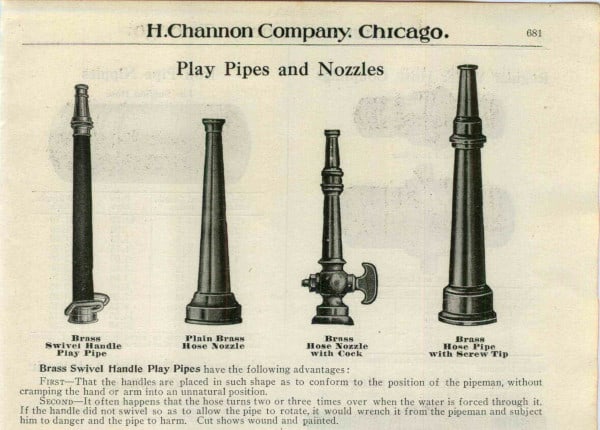
In firefighting applications, what playpipes are and what they can do are now defined largely by manufacturing standards from two organizations: UL and FM Approvals. UL 385: Standard for Play Pipes for Water Supply Testing in Fire Protection Service sets standards for playpipes designed exclusively for flow testing. FM 1411: Approval Standard for Playpipes recognizes playpipes as both a firefighting and flow-measuring tool, and sets standards for them in two lengths: 30 inches for Underwriter-type playpipes and 15 inches for shorter versions. FM even prescribes specific dimensions for the Underwriter-type playpipe: a 24 9/16″ straight tube and a 5″ long tapering tip.
Approvals govern how these devices are made in detail, resulting in a product well-suited to the needs of inspectors
The design and definition of playpipes have gradually evolved, morphing from short, tapering lengths of pipe to graspable tools with a special role in firefighting. While it’s not clear why the name was chosen, listed firefighting playpipes now provide purchasers with a clear set of expectations. FM-approved nozzles are hydrostatically tested, feature guaranteed minimum discharge coefficients, and can withstand repeated impacts without a loss of performance.
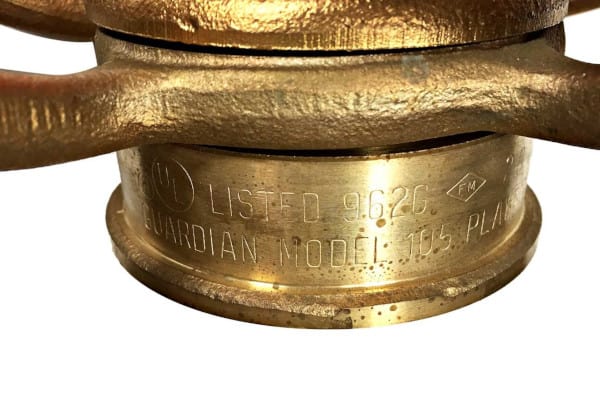
QRFS offers UL-listed and FM-approved underwriter’s playpipes made with 30 inches of durable, cast-brass pipe. They feature a standard 2 1/2-inch NST-threaded inlet and a 1 1/8-inch removable tip that secures to a 1 3/4-inch outlet.
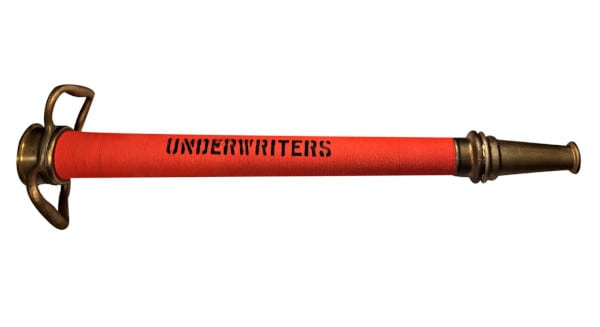
Each underwriter’s playpipe features large brass swivel handles for maximum control. Red marlin fiber wraps around the pipe, providing a non-slip grip during hydrant flow tests.
Check out our UL & FM-approved underwriter’s playpipe.
Questions about firefighting playpipes? Call us at +1 (888) 361-6662 or email support@qrfs.com.
This blog was originally posted at blog.qrfs.com. Follow us on Facebook.com/QuickResponseFireSupply or on Twitter @QuickResponseFS.


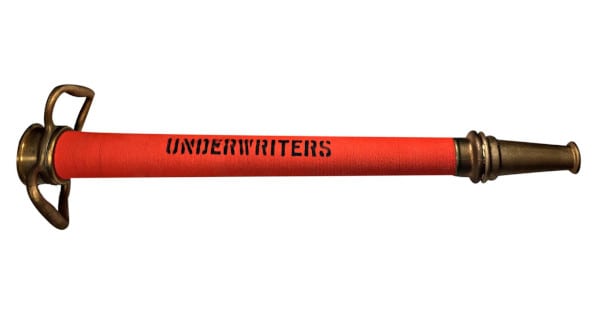
pkease I need quotation for 1 NOZZLE UNDERWRITES PLAYPIPE WITH TIP-UL/FM APPROVED and delivery time
regards
Sandra, thank you for reaching out. We will have someone from our QRFS Customer Support Team contact you.
I am looking for the specifications of the Marlin Cord used to wrap these nozzles. I have three that I would like to restore but can’t find specifications on the cord itself.
Thanks
Nick
Nick — Thanks for reading. Honestly, we aren’t certain of the specs of the wrap itself immediately, or what specs you are looking for (size, material, etc.) You can contact a manufacturer and they may have more explicit detail on the wrap portion: https://www.guardianfire.com/contact.php
Do you supply Underwriters Playpipe with Tip-UL/FM Approved 2 1/2-inch (63.5mm) in United Arab Emirates (UAE) particularly Dubai?
Christian – thank you for reaching out. We will have someone from our QRFS Customer Support Team contact you, and you can also email any requests there!
I would like to request for a quotation of underwriter playpipe & other.
ITEM NO. ITEM DESCRIPTION QTY. UOM
1 WRENCH, EXTRA LARGE ORIFICE, 3/4″, MODEL NO: 333010 – 1 pc
2 WRENCH, MILLENIUM, 1/2″, MODEL NO: 332334 – 1 pc
3 WRENCH, ADJUSTABLE HYDRANT, DOUBLE SPANNER HEAD, STYLE 105/105S – 1 Pc
4 PLAYPIPE, 2½” x 30”, BRASS, NST THREAD, C/W BRASS TIP – 2 Sets
5 TORQUE DRIVER – 2 Pcs
6 TORQUE WRENCH – 2 Pcs.
Thank you.
Erna
Thank you for reaching out. We will have someone from our QRFS Customer Support Team contact you, and you can also email them any requests there to get faster service!
Do you have 19mm tip-BRASS Taper nozzle to fit with your Underwriters Playpipe thread size. We already have your setup but now we need it with different tip for some other requirement. It is required in United Arab Emirates (UAE) particularly Dubai. If yes, please send email to “subramaniam.shivalingham@eslglobal.com”
I am expecting your reply,
BR
We will have someone from QRFS customer support contact you. You can also always email support@qrfs.com for faster service in the future. Thanks!